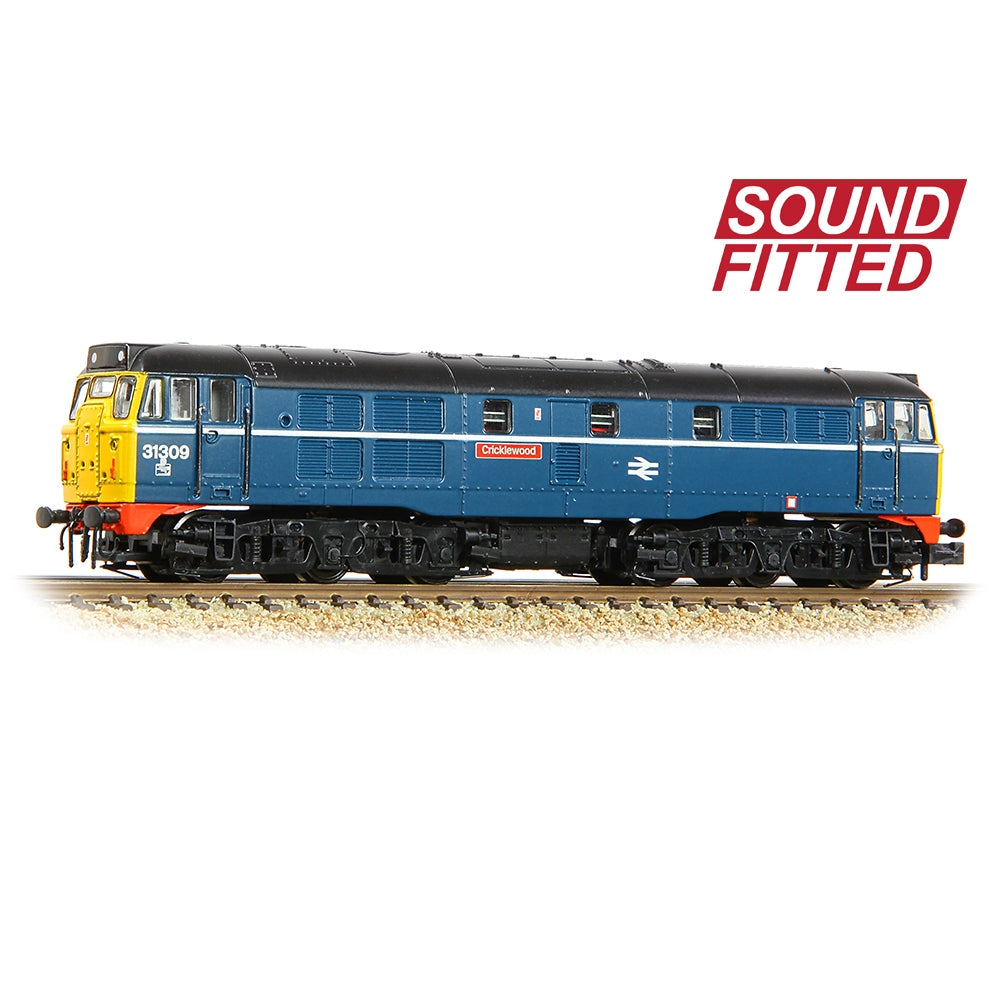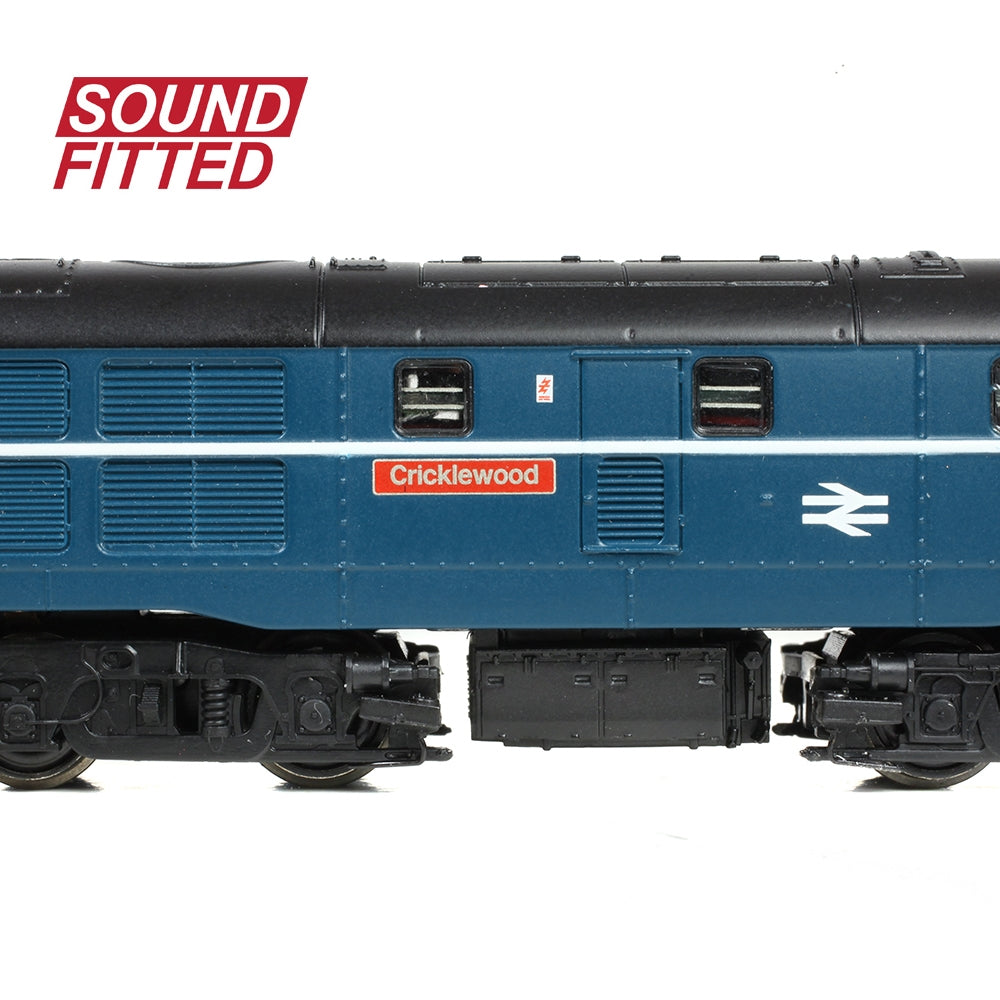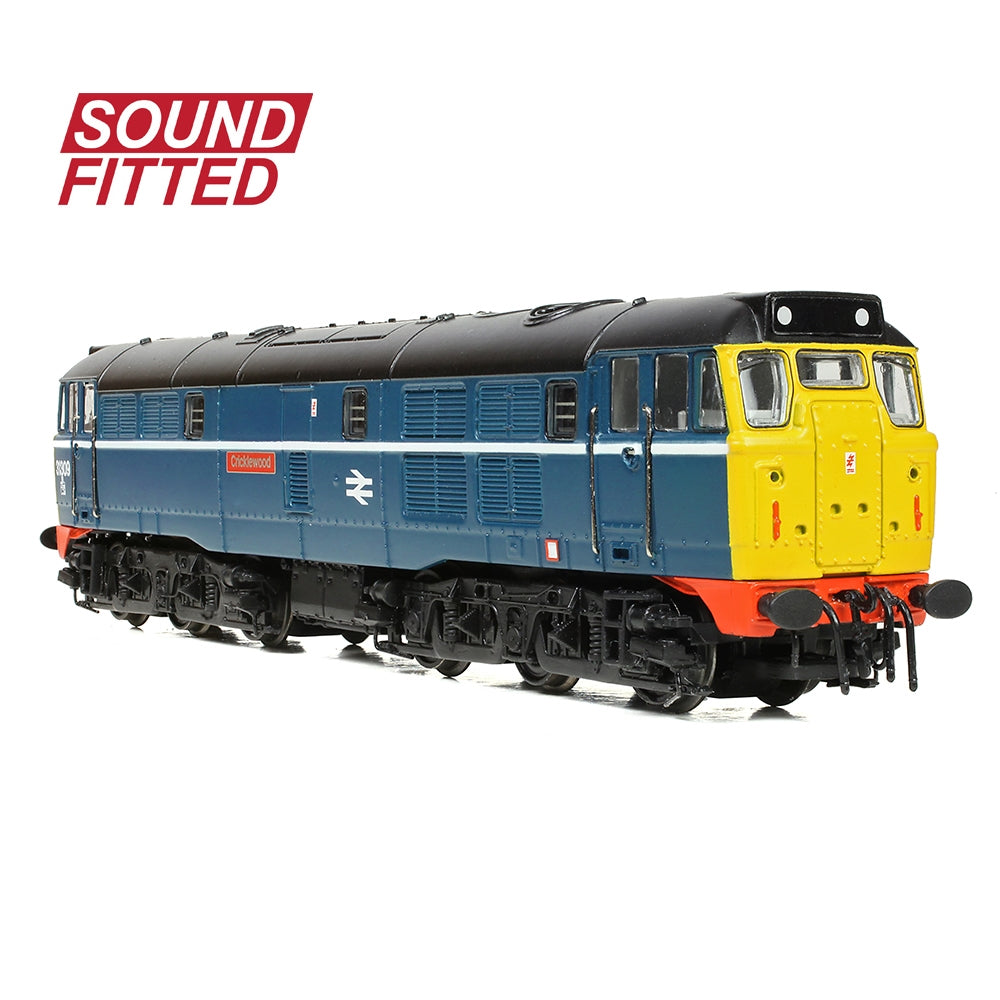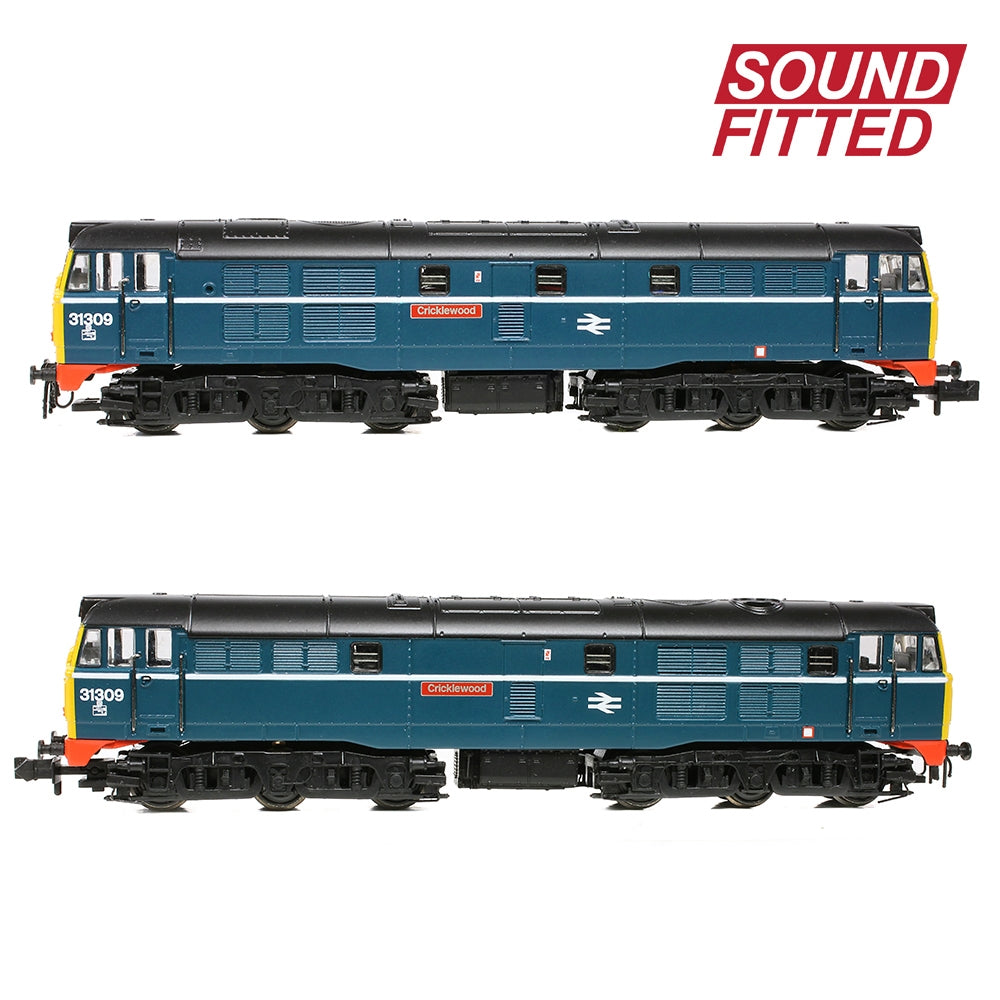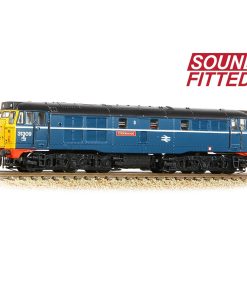GRAHAM FARISH Class 31/1 31309 ‘Cricklewood’ BR Blue DCC Sound Fitted GRAHAM FARISH
$ 414,99 $ 124,50
GRAHAM FARISH CLASS 31/1 31309 ‘CRICKLEWOOD’ BR BLUE (SOUND FITTED)
Announced as part of the Winter 2022 British Railway Announcements, Bachmann are delighted to present the Graham Farish Class 31/1 as No. 31309 ‘Cricklewood’ in BR Blue livery complete with SOUND FITTED.
The Class 31 is a favourite among enthusiasts and this Graham Farish model is a faithful rendition of these fan-favourites. The BR Blue livery applied to ‘Cricklewood’ was enhanced by its namesake depot with the addition of red bufferbeam cowling and the white bodyside stripe, a throwback to the livery in which the Class 31s were delivered when first built. This livery is expertly applied to the Graham Farish model using authentic colours, logos and fonts. Suitable for use on DCC or analogue control straight out of the box, this SOUND FITTED model will take your enjoyment to the next level with its authentic sound effects which only enhance the model’s good looks!
MODEL FEATURES:
- Graham Farish N Scale
- Era 8
- Pristine BR Blue livery
- Running No. 31309
- Named ‘Cricklewood’
- Accessory Pack
- NEM Coupling Pockets
- Coreless Motor
- Directional Lighting – independently switchable at each end via switches mounted on the circuit-board, or via DCC
- SOUND FITTED – Fitted with a Zimo MX659N18 Sound Decoder – See below for the function list
- Length 116mm
SOUNDS
F0 – Directional Lights
F1 – Engine Start (Sound On/Off)
F2 – Brake
F3 – Single Horn (Speed and Direction Related)
F4 – Two-Tone Horn (Speed and Direction Related)
F5 – Light Engine
F6 – Engine Idle
F7 – Speed Lock
F8 – Cold Start (F8 On before F1)
F9 – Flange Squeal (Speed Related)
F10 – Despatch Whistle
F11 – Buffering Up
F12 – Coupling Up
F13 – Compressor
F14 – Spirax Valves
F15 – Cooler Group Fan
F16 – Primer
F17 – Auto Wagon Buffering (F17 On & F5 Off only)
F18 – On – Driver’s Door Opening / Off – Driver’s Door Closing
F19 – Fade All Sounds
F20 – Directional Lights Off – No. 1 End (Fan)
F21 – Directional Lights Off – No. 2 End (Non-Fan)
F22 – ‘Right o’ way’
F23 – ‘Going under’
F24 – Station Ambience
F25 – Detonators
F26 – Shunt Mode
F27 – Volume Down
F28 – Volume Up
Analogue Users: Directional lights and basic Prime Mover (engine) sounds, which vary with speed, plus any other automated sounds, can be enjoyed when using this model on analogue control (DC) straight from the box!
CLASS 31 HISTORY
The BR Class 31 Diesel Locomotives, originally known as the Brush Type 2s, were built by Brush Traction from 1957-1962, with a total of 263 locomotives constructed. The first Class 31 entered service in November 1957 and the design was one of the Pilot Scheme locomotives ordered by British Railways to replace steam traction. The Class was originally allocated to the Eastern Region, but gradually became common on both the Western and London Midland regions too.
The Class 31/1s were the standard locomotives, distinguished from the first batch of locos – the 31/0s – which had Red Circle multiple-working control equipment, a non-standard feature that led to them being withdrawn relatively early in the late-1970s. The 31/1s were fitted with Blue Star multiple-working equipment, as found on many other BR classes, and all had steam heating boilers from new, making them ideal for hauling passenger services. The Class 31/1s could be found on a variety of secondary and relief passenger duties as well as parcels and freight traffic. Commonly used in East Anglia, with allocations at Stratford and March depots, they were also found throughout the Eastern Region of BR with Finsbury Park sporting a large allocation, along with the depots at Tinsley, Immingham and Thornaby. Examples were also allocated to Bristol Bath Road and Old Oak Common on the Western Region, where they could be found working passenger trains as far west as Barnstaple and Paignton. In the early 1980s, Healey Mills and Bescot on the Midland Region also gained an allocation as replacements for Class 25s.
During the 1970s some Class 31s were fitted with Electric Train Heating (ETH) and these were reclassified as 31/4s to denote this feature. The 1980s would see BR undertake a programme of refurbishment for much of the fleet, this included the fitting of ETH to more locomotives but refurbishment was not reserved exclusively for the 31/4s, Class 31/1s were also refurbished without receiving ETH equipment. During refurbishment bufferbeam cowlings were removed along with the bodyside band, headcode boxes were plated over and fitted with two marker lights, and any remaining disc headcodes were removed. Where steam heat boilers remained, these were removed and a concrete block added instead to maintain the weight balance.
As passenger work dried up, many of the 31/4s were displaced and found themselves allocated to the departmental sector. In 1990, to reduce maintenance costs and prevent their ETH-fitted locos being borrowed for passenger work when extra traction was needed, the departmental sector isolated the ETH and removed the jumper cables from some of its 31/4s, resulting in these locos being reclassified as 31/5s. There were also two locomotives classified as 31/6, these had through ETH wiring fitted allowing them to work double-headed with an ETH-fitted loco.
The first withdrawal came in 1975 following accident damage, but most survived until the 1990s when EWS took on 153 examples from BR’s Transrail and Mainline freight divisions, although EWS spent little time running down its inherited fleet. Other operators however kept Class 31s active on the mainline and in 2022 it is still possible to see a 31 on the mainline. The Class has also been popular with the preservation movement, with more than 25 examples now preserved.
Quick Shipping and Professional Packaging
Due to our long-term partnership in a long-standing partnership with UPS, FedEx, DHL and many other leading global carriers, we are able to offer an array of shipping options. Our warehouse staff are highly trained and will pack your products according to our precise and precise specifications. Your items will undergo a thorough inspection and be securely secured prior to being delivered. We ship to thousands clients each day across multiple countries. This is an indication of our dedication to being the biggest online retailer in the world. The warehouses are located in Europe as much as they are in the USA.
Note: Orders that include more than one item are assigned a processing time in accordance with the item.
Prior to shipment before shipping, we'll inspect thoroughly the items you've ordered. The majority of orders are shipped within 48 hrs. The time to deliver varies from 3-7 days.
Returns
We don't manage the stock in our warehouse and factory. Stocks are subject to change at any moment. You may not receive your order after the order has been made.
Our policy is for 30 days. If you have passed 30 days by since your purchase, unfortunately we can't offer you a refund or exchange.
The item cannot be used and in its original condition. It should also be in the original packaging.
Related products
RADIO CONTROL
RADIO CONTROL
RADIO CONTROL
RADIO CONTROL
RADIO CONTROL
RADIO CONTROL
RADIO CONTROL
RADIO CONTROL
RADIO CONTROL
(Clearance Item) HB RACING 44mm Heavy Duty Universal Drive Shaft/Rear/Steel/2Pcs HB RACING
RADIO CONTROL
RADIO CONTROL
RADIO CONTROL
RADIO CONTROL
RADIO CONTROL
RADIO CONTROL
(Clearance Item) HB RACING 5 Cell Main Chassis 2.5mm with Battery Tray (Cyclone) HB RACING
RADIO CONTROL
